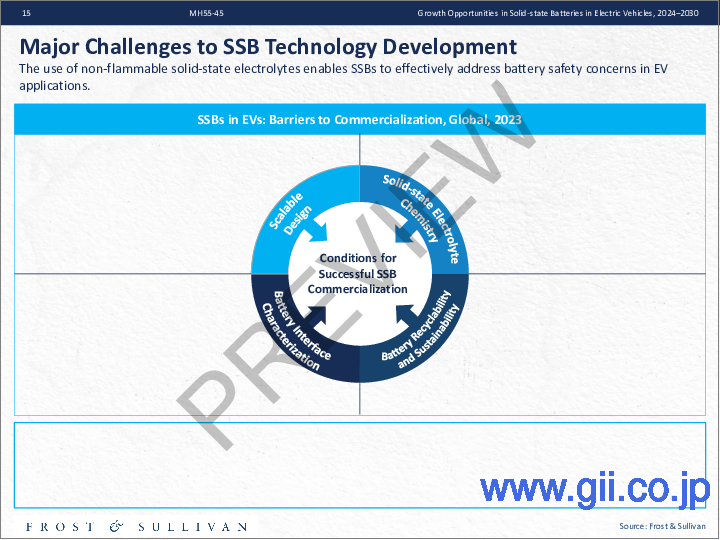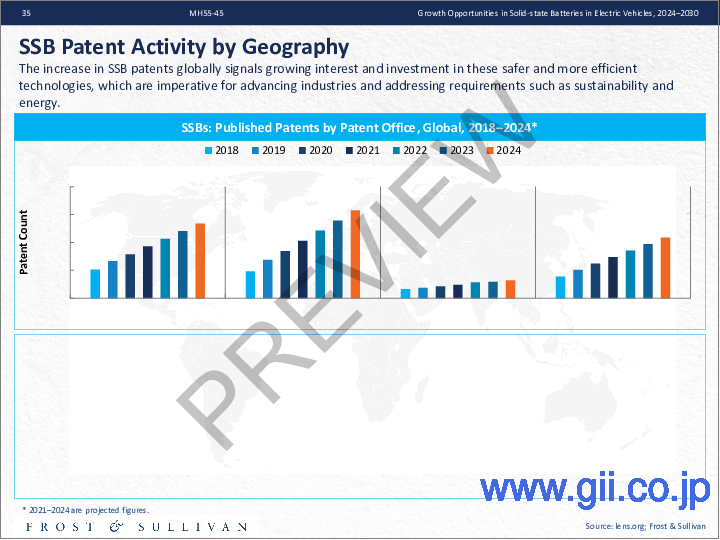|
|
市場調査レポート
商品コード
1620284
電気自動車における固体電池の成長機会、2024年~2030年Growth Opportunities in Solid-state Batteries in Electric Vehicles, 2024-2030 |
||||||
|
|||||||
| 電気自動車における固体電池の成長機会、2024年~2030年 |
|
出版日: 2024年12月06日
発行: Frost & Sullivan
ページ情報: 英文 57 Pages
納期: 即日から翌営業日
|
全表示
- 概要
- 目次
持続可能なEVパワーソリューションの技術的進歩、市場動向、今後のロードマップ
固体電池(SSB)は、革新的な材料、先進的な製造技術、戦略的な協力関係によって、電池技術における革新的な飛躍を意味します。研究開発と戦略的パートナーシップにおける協調的な取り組みが商業化への道を加速しており、世界のEV市場に大きな影響を与えることが期待されています。
本調査では、SSBが電気自動車(EV)の広い文脈でどのような可能性を秘めているのか、その特質と障害について要約しています。SSB技術の進化と進歩の概要に加え、新材料開発がどのように商業化を可能にし、機会を創出し、世界のEVの展望を構成するかについても論じています。SSBは、リチウムイオン(Li-ion)電池よりも環境負荷が低い一方で、高出力と低製造コストを実現します。さらに、コスト効率が高く、エネルギー密度が高く、重量が軽いです。
こうした要因がSSBの採用を後押ししているにもかかわらず、このセグメントには大きな技術的・工学的ボトルネックがあり、一部のポリオレフィン-エチレン製品の熱管理は量産を阻害する主な障壁の一つとなっています。広範なコスト分析によると、SSBは高水準の安全性とエネルギー効率を実現します。しかし、将来的にはコストが下がり、SSBがより魅力的な価値提案になると予想されます。
本調査では、トヨタ、フォルクスワーゲン、現代自動車を含む主要企業間の重要な合併や提携も取り上げています。このような協力関係は、SSBの開発を進め、次世代EVの用途でSSBの可能性を最大限に実現する上で主な鍵となります。こうした提携は、車両の航続距離と充電速度を向上させるためのバッテリー性能を支持するものです。
世界のSSB市場は、特許活動の活発化とOEMによる財政投資によって、飛躍的な成長を遂げる態勢が整っています。電池化学が進歩し、統合された製造クラスターが出現する一方で、SSBは電動モビリティを次の段階に進めるために不可欠なものとなると思われます。この移行は競合情勢をさらに浮き彫りにしており、情勢に左右される自動車メーカーと新興自動車メーカーが先端電池技術の覇権を争っています。
目次
戦略的課題
- なぜ成長が難しくなっているのか?
- The Strategic Imperative(TM)
- 固体電池(SSB)市場に与える上位3つの戦略的重要事項の影響
成長機会分析
- 分析範囲
- 調査の目的と目標
成長環境
- SSBの開発
- EVにおける主なSSB採用動向
- SSB技術開発における主な課題
- 電動モビリティにおけるSSBの利点
- 電動モビリティへのSSB採用における課題
- リチウムイオン電池とSSBの比較
- SSBのコスト計算
- 将来のSSBコスト計算
- SSBの合併
- EVにおけるSSBの主な価値提案
- 進化する電池化学の技術ロードマップ
- SSB製造クラスター
- SSB技術と密度
- 主要OEMによるSSBの採用
- OEMによる既存化学と将来化学の採用比較
- バッテリーエネルギーシステムのエネルギー:デバイス別(2023年)
- SSBの世界市場規模(2018年~2030年)
特許活動
- 地域別のSSB特許活動
- SSB特許活動の競合情勢
SSB企業
- QuantumScape
- Solid Power
- Blue Solutions
- Contemporary Amperex Technologuy Co., Limited(CATL)
成長機会領域
- 成長機会1:SSB技術の実装を推進する大量生産
- 成長機会2:研究開発の重点分野
- 成長機会3:規制と標準化の重点分野
付録と次のステップ
- 成長機会の利益と影響
- 次のステップ
- 別紙リスト
- 免責事項
Technological Advancements, Market Trends, and Future Roadmap for Sustainable EV Power Solutions
Solid-state batteries (SSBs) represent a transformative leap in battery technology, relying on innovative materials, advanced manufacturing, and strategic collaborations. Concerted efforts in R&D and strategic partnerships are accelerating the path toward commercialization, promising a significant impact on the global EV market.
This study summarizes the specialties and obstacles and highlights the potential SSBs wield in the broader context of electric vehicles (EVs). In addition to outlining the evolution and advances in SSB technology, it discusses how new materials development enables commercialization, creates opportunities, and structures the global EV landscape. SSBs have a lower environmental impact than lithium-ion (Li-ion) batteries while offering higher power and lower manufacturing costs. In addition, they are more cost-effective, energy-dense, and weigh less.
Despite these factors driving the adoption of SSBs, the segment has significant technological and engineering bottlenecks, with thermal management of some polyolefins-ethylene products as one of the main barriers inhibiting mass production. Extensive cost analysis suggests that SSBs deliver a high level of safety and energy efficiency; however, manufacturing costs remain high because of shell material prices. Nonetheless, costs are expected to fall in the future, making SSBs a more compelling value proposition.
The study also covers important mergers and partnerships among major players, including Toyota, Volkswagen, and Hyundai. Such collaborations are key in advancing the development of SSBs and realizing their full potential for next-gen EV use. These partnerships champion battery performance for improved vehicle range and charging speeds.
The global SSB market is poised to experience exponential growth heightened by growing patent activity and financial investments from OEMs. While battery chemistries move forward and consolidated manufacturing clusters emerge, SSBs will become indispensable to moving electric mobility to the next stage. This transition further highlights the competitive landscape, with legacy automakers and upstarts jockeying for dominance in advanced battery technology.
Table of Contents
Strategic Imperatives
- Why is it Increasingly Difficult to Grow?
- The Strategic Imperative™
- The Impact of the Top 3 Strategic Imperatives on the Solid-state Battery (SSB) Market
Growth Opportunity Analysis
- Scope of Analysis
- Research Aims and Objectives
Growth Environment
- Development of SSBs
- Key SSB Adoption Trends in EVs
- Major Challenges to SSB Technology Development
- Benefits of SSBs for Electric Mobility
- Challenges in Adopting SSBs for Electric Mobility
- Li-ion Batteries vs SSBs-A Comparison
- SSB Costing
- Future SSB Costing
- Mergers for SSBs
- Key Value Propositions of SSBs in EVs
- Technology Roadmap for Evolving Battery Chemistries
- SSB Manufacturing Clusters
- SSB Technology and Density
- Key OEMs' Adoption of SSBs
- OEM Adoption of Existing vs Future Chemistries
- Specific Energy of Battery Energy Systems by Device, Global, 2023
- SSB Global Market Size 2018-2030e*
Patent Activity
- SSB Patent Activity by Geography
- Competitive Landscape of SSB Patent Activity
SSB Companies
- QuantumScape
- Solid Power
- Blue Solutions
- Contemporary Amperex Technology Co., Limited (CATL)
Growth Opportunity Universe
- Growth Opportunity 1: Mass Manufacturing to Drive SSB Technology Implementation
- Growth Opportunity 2: R&D Focus Areas
- Growth Opportunity 3: Regulatory and Standardization Focus Areas
Appendix & Next Steps
- Benefits and Impacts of Growth Opportunities
- Next Steps
- List of Exhibits
- Legal Disclaimer





